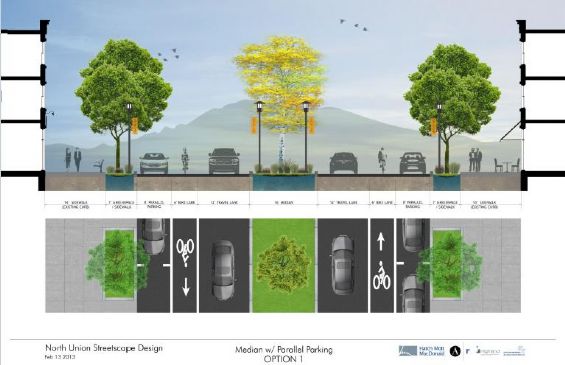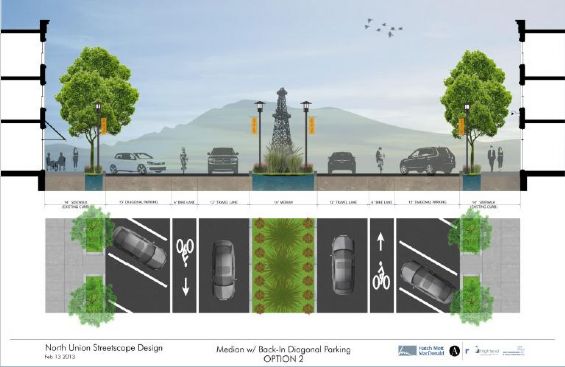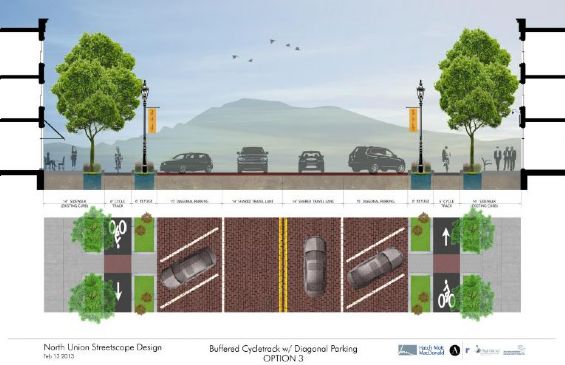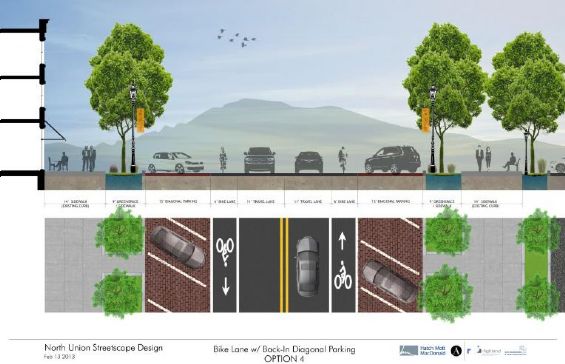|
These four streetscape concepts were presented and discussed first at a Public Meeting in February and then again on March 27th when Dan Burdened presented at JCC. In May, the refined and recommended streetscape was presented at a City Council Meeting prior to Councilors voting to approve the application for grant funding to perform the NUS project. With parallel parking, this idea - Scheme 1, affords wider sidewalks which would enable more on-street dining for restaurants. Bike users and business owners preferred the angle parking concepts for different reasons. Cyclists are wary of riding alongside parked cars because they could be “clotheslined” by a suddenly opened door. Business owners know that angle parking affords twice as much parking and this is good for customer traffic. Ultimately, it was felt that our sidewalks are currently wide enough for on-street dining and a generous walkway so angle parking prevailed. By adding a wide bike lane / safety lane in front of angle parking it makes it much easier to get into and out of spaces. This concept - Scheme 2, shows the “back-in” format but the “head-in” format is also possible by simply changing the angles of the paint stripes.  In both formats, the bike / safety lane provides a refuge for cars to maneuver in and out of parking spaces without stopping the flow of traffic. This is the concept that was refined and further developed in the projects STEP grant application and in the successful TIGER grant application. In both formats, the bike / safety lane provides a refuge for cars to maneuver in and out of parking spaces without stopping the flow of traffic. This is the concept that was refined and further developed in the projects STEP grant application and in the successful TIGER grant application. Scheme 3 seemed very attractive to cyclists… at first blush. But doubts emerged. The City felt that maintenance of the “cycle tracks” would be costly and ultimately, underfunded. If they were not kept clean and plowed, bicycles would be forced back into the road or the sidewalks. After studying cycle tracks in action elsewhere, we learned that they should not be constructed in a central business district. In the CBD the goal is “traffic calming” – for all vehicles including bicycles. Cycle tracks encourage high-speed peddling right where pedestrians least expect to be hit by a bike – while walking from storefront to curb. Other problems with this scheme include angle parking without a buffering bike/safety lane – basically the same problematic layout that we have today. The single lanes separated only by a yellow paint stripe seemed insufficient to discourage left turns. We want drivers to use the roundabouts for u-turns so they’ll never need to turn left. Scheme 4 has some good features including the angle parking buffered by a substantial bike/safety lane. By eliminating the median we gain space for even wider sidewalks which would encourage on-street dining – a good way for restaurants to tap into expansion space during the busiest summer nights. The biggest problem here is that we are not providing pedestrians with a mid-street refuge. Although the crossing distance is much narrower than today’s North Union Street, pedestrians would still need to traverse 34 feet of moving traffic and watch for cars and bikes coming from two directions at once. This concept was tabled in favor of the median concept 2 but it could be resurrected if we could agree upon the addition of pedestrian safety enhancements like “crossing islands” to provide a mid-street refuge or “speed table crosswalks” – essentially very wide speed bumps with a crosswalk on top which would virtually force traffic to wait for pedestrians. All things considered, medians provide a better, safer solution while permitting more free-flowing traffic.
|